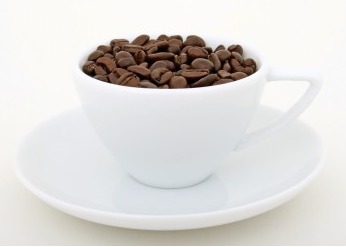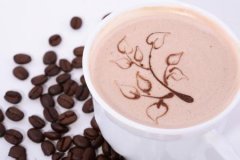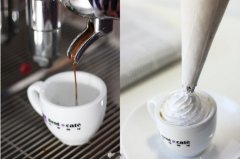Roasting determines coffee taste Coffee Roasting basics

Generally speaking, each coffee cherry contains two raw beans, and the fragrance is still hidden, waiting to be discovered. In raw beans, it contains a lot of chloric acid. As the baking process, chloric acid will gradually disappear, releasing familiar and pleasant fruit acid-such as acetic acid, citric acid, malic acid in wine. Baking is just right, can present these beautiful sour taste moderately; on the contrary, if the baking is too much, it will completely cover them up.
Baking decides the taste.
A book about coffee says,'80% of the taste of coffee is determined by the bakering.' We don't know how this percentage is calculated, but the importance of baking in coffee production is not exaggerated.
Baking, as the name implies, is to provide heat to coffee beans, and to produce chemical changes in the internal structure of coffee beans by heating, that is, heating converts starch in raw beans into sugar 5 or acidic substances at high temperature. substances such as cellulose will be carbonized to varying degrees by carbon, water and carbon dioxide will be evaporated, proteins will be converted into enzymes, and the remaining substances of fat will be combined. An oil film is formed on the surface of coffee beans.
The main purpose of baking is to produce this aromatic oil, which is called coffee oil, or, more accurately, coffee oil, which gives coffee beans a strong aroma. This aromatic oil is volatile, that is, it is the main factor that brings flavor and fragrance, and they can accommodate water, which means that people can enjoy it in a cup.
Baking must be uniform, the most important thing is to be able to stir-fry the beans evenly inside and outside. At first, the water in the coffee beans should be discharged smoothly by fire. if only fast and uneven is required, it may cause the beans to have a beautiful appearance but a light internal color, and has not yet begun to decompose. The deep, medium and shallow companionship of beans during baking is decided and controlled by people, and even there is a knack for cooling beans before the end of baking. If the temperature is not cooled quickly, the heat contained in beans will make the beans darker and greasy, and the taste will become bitter.
Baked coffee beans swell, a bit like popcorn, and crackle during baking, just as we make popcorn in a microwave oven. But because the skin on the surface of coffee beans is very tough, we usually don't see coffee beans crack like popcorn.
The color of roasted coffee beans changes from light green to tea brown, which can not only change the unique color of amber, flavor and aroma, but also volatilize the sour, sweet, bitter, mellow and fragrant five obvious taste characteristics of coffee. If the baking technology is good, the beans will be large and expanded, no wrinkles on the surface, uniform luster and each has its own different flavor.
Shallow baking. Moderate baking. Deep baking
The baking of coffee beans can be divided into shallow baking according to the degree of baking. Moderate baking. There are three categories of deep baking. Generally speaking, the light baking color is lighter, the sour taste is strong, and it has a unique flavor. The deep baking color is darker, the deeper the sour taste is, and the more bitter it is, but the scorched smell of baking makes the aroma more intense.
The only common term among coffee bakers is bottom, medium, and deep. Or sometimes use light, medium and black, which have different meanings for different kinds of coffee.
Shallow baking
Shallow accompany, such as cinnamon baking, has a more meticulous and mild aroma.
There are a few different words for this kind of baking. Light is mild, Half City is half-city, and in the United States, people often use the word city to refer to coffee baking, Cinnamon cinnamon or light brown NewEngland New England style-this is the lightest kind of baking. Cinnamon is usually a high degree of baking in this category, and the beans baked in this way usually have a sour taste. When the beans make the first light sound and the volume expands at the same time, the color changes to a delicious cinnamon color, so it is also called cinna-mon roast or half-city roast. Acidity dominates the flavor of shallow accompany beans, and the texture and taste have not been brought into full play, so they are generally used as canned coffee, which can not meet the real coffee experts.
Moderate baking
Chinese accompany, also known as' urban baking'or 'American baking', is more mellow. There are the following, Full City, American American, Medium medium, High depth, Breakfast Breakfast Regular regular Brown Brown.
When baked for 11 minutes, the coffee beans show an elegant brown color. New Yorkers like to start the day with coffee beans and Shannon's milk and sugar at breakfast, so this method of baking is also called breakfast roast or city roast. Chinese companion can not only preserve the original flavor of coffee beans, but also moderately release fragrance, so Nanshan, Colombia, Brazil and other individual coffee, choose this way of roasting.
At 12 Mel for 16 minutes, the oil began to surface, and the beans were burnt into an oily dark brown, called full-city roast. Some people think that at this time, the sour, sweet and bitter taste of coffee reaches the most perfect balance, and the characteristics of coffee beans are clearly depicted.
Among these moderate baking degrees, Medium is very sour and mellow, which is the most suitable for making comprehensive coffee. High coffee beans have the most mild sour taste and a touch of bitterness, which is suitable for Nanshan Coffee and is deeply loved by Japanese and European consumers. Flavors such as city, which are more bitter than sour, are suitable for Colombian coffee or Brazilian coffee. For city-flavored coffee, the higher the degree of baking, the higher the bitterness will cover the sour taste. South Americans usually like the bitter city taste, while Americans like to use this coffee to make summer ice drinks.
Deep baking
Including French (French). Continental (continental) Aafter Dinner (after dinner). Italian (Italian). Among them, the French-baked coffee beans will have a kind of black dark brown on the surface, while the Italian-baked coffee beans will have an obvious glossy surface. Espresso is usually made from deep-roasted coffee, on the one hand, to taste the coffee after adding milk, cream, or chocolate, and the strong flavor of a small amount of coffee can also help people drink less.
Deep baking, the darker the color of coffee beans, sweet flavor, oil has been turned into caramel, bitterness. Endless aftertaste, the most suitable for brewing strong Italian espresso, so it is also called Italian baking method.
Moderate baking gives coffee beans life and turns into an intriguing sour, sweet and bitter taste. However, people who are sensitive to caffeine should choose the beans that accompany them as much as possible, because during the baking process, the caffeine will slowly disappear, so the deeper the beans, the lower the caffeine content. It is said that the caffeine content in each cup of Italian thick-locked coffee is only half that of other baked coffee.
The color of beans baked in Vienna is darker than that in Chinese, while French baking, Italian baking and mainland baking are dark brown, close to black, producing attractive mellow bitterness, such as espresso.
Extra-deep baking
There are usually Dark French (Deep French) and Heavy (extra heavy flavor). This is often to satisfy the hobbies of some special coffee lovers, and some people bake this bitter coffee at home, with a faint smell of cigarette ash.
Metropolises all over the world have their own preference for baking. In Tokyo, micro-deep moderate baking (high-roast) is more popular, but gradually tends to deep baking, while Brazil has always been more popular.
And New York, as its name, generally prefers city roast, but because the city is inhabited by a variety of different races, it also sells a variety of coffee beans with different degrees of roasting. Vienna, on the other hand, prefers deep-baked full-city roast. And more like its name, the French prefer French-style baking, while the Italians often use Italian-style baking.
However, in recent years, people in Europe and the United States have widely used German (high-city) and dark (the most commonly used deep baking in Brazil and Italy), and the changes are also colorful, while the coffee made by steam pressurizer is still popular.
The vocabulary is richer in the United States, such as "full-city toast". This is usually used to indicate that coffee beans are about to reach the stage of "dark", "black" or "European flavor".
No one can answer why you can't mix "light" and "black" coffee. If you want to do that, you should keep in mind that some toasters are not suitable for baking some coffee, just as some coffee is suitable for drinking at different times of the day. For example, deep-roasting Ethiopian coffee beans would be a waste because it would lose the characteristics of the coffee.
On the other hand, when some coffee beans are baked in black, they will produce new and interesting qualities, such as Mexican coffee beans that produce an interesting sweetness when baked in black.
But some coffee beans, such as Guatemala Antigua coffee beans, retain their sour and fruity flavor when they are deeply roasted, which is more difficult for other coffees. In addition, Sumatra coffee beans are usually full-grained, but are lower than medium acidity and lose acidity when roasted deeper and tend to become sugar paste.
Generally speaking, the darker the baking is, the lower the quality is, and the deeper baking means that most of the flavor of the coffee beans will be lost.
- Prev

The tendency of coffee roasting in countries around the world
Coffee in the world has its unique baking tendency, creating a unique color, aroma and taste of coffee. Roasting turns the light green raw coffee beans into the familiar brown coffee beans. In Tokyo, micro-deep medium baking is more popular, but slowly it also tends to deep baking. As for Kansai, deep baking has been popular in the past. New York, as its name suggests, is generally biased.
- Next

Gas baking with charcoal fire baking with infrared baking
According to the different heat sources used, the baking of coffee can be divided into gas baking and charcoal fire baking and infrared baking. One of the most commonly used is gas baking, the temperature is controlled between 200 Mel and 300 degrees Celsius, and the temperature should be adjusted from time to time according to the need. Most baking stoves use gas, the temperature is about 290 degrees, in the first 5 minutes, free
Related
- Beginners will see the "Coffee pull flower" guide!
- What is the difference between ice blog purified milk and ordinary milk coffee?
- Why is the Philippines the largest producer of crops in Liberia?
- For coffee extraction, should the fine powder be retained?
- How does extracted espresso fill pressed powder? How much strength does it take to press the powder?
- How to make jasmine cold extract coffee? Is the jasmine + latte good?
- Will this little toy really make the coffee taste better? How does Lily Drip affect coffee extraction?
- Will the action of slapping the filter cup also affect coffee extraction?
- What's the difference between powder-to-water ratio and powder-to-liquid ratio?
- What is the Ethiopian local species? What does it have to do with Heirloom native species?

